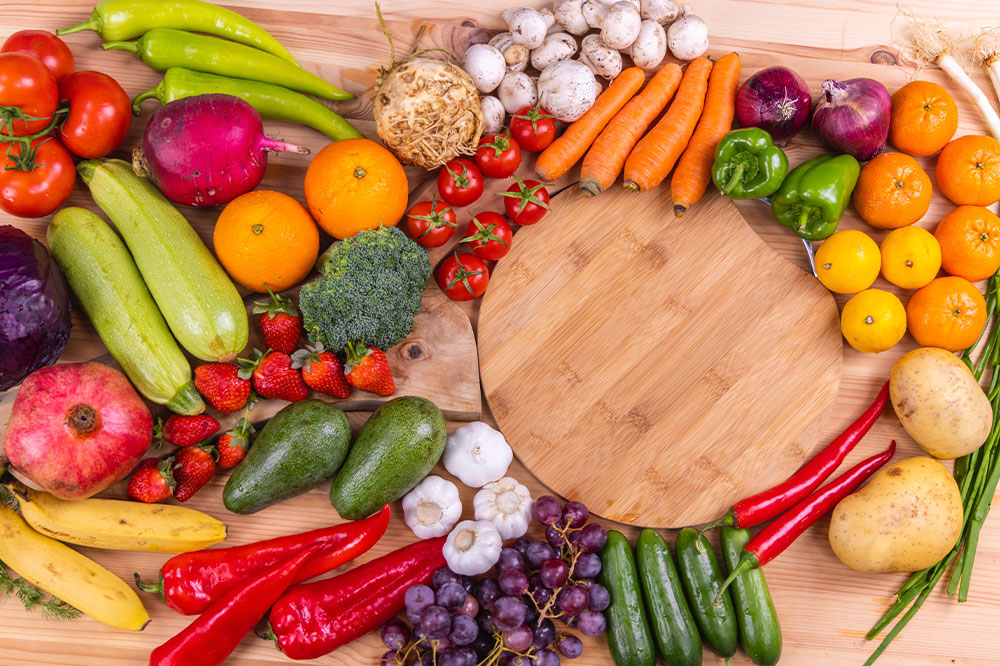Health benefits of fruits and vegetables
The importance of fruits & vegetables cannot be overemphasized. Full of vitamins and essential nutrients, there are rarely any side effects when binging fruits & vegetables. They help in healing the body, preventing illnesses, and promoting well-being. This cannot be said about the other food products, such as sugar and processed foods.

Types of Fruits & Vegetables
Fruits & vegetables are available in a variety of colors, shapes, and sizes. They vary according to the season, while a few are available throughout the year. Each fruit or vegetable is rich in a few vitamins and minerals. Therefore, eating various fruits & vegetables is essential to ensure the body receives the entire range of nutrients.
Types of fruits
Stone fruits: These are characterized by the presence of a hard stone or pit in the middle of the fruit, surrounded by the fleshy part of the fruit. Stone fruits include apricots, peaches, nectarines, and plums.
Citrus fruits: These fruits contain a thick outer membrane and a thin inner fleshy part that is segmented. Common citrus fruits include oranges, lemons, grapefruits, pomelo, and kumquat.
Tropical fruits: These fruits grow south of the Tropic of Cancer in warmer climates. Popular tropical fruits include bananas, mangoes, pineapples, papayas, and coconuts.
Berries: Berries are of small size with bright colors and pulpy flesh. These fruits include strawberries, blueberries, and raspberries.
Melons: These round-shaped fruits are characterized by thick and hard skin with multiple seeds inside the fruit. Various types of melons include watermelons, honeydew melons, and muskmelons.
Pome fruits: Pome fruits have a fleshy outer covering surrounding a few seeds in the core. The most popular pome fruits are apples and pears.
Types of vegetables
Vegetables are classified based on which part of the plant is edible.
Leafy green vegetables: As the name suggests, the leaves of these vegetables can be consumed. Leafy greens include spinach, kale, lettuce, and chard. These have a high nutrient content.
Tubers: These are the edible underground stems of plants. Tubers include potatoes, sweet potatoes, yam, and taro, typically high in starch.
Root vegetables: These are edible roots and include carrots, turnips, beets, and radishes.
Cruciferous vegetables: These refer to the flower or head of the vegetable and include cabbage, cauliflower, brussels sprouts, artichokes, and broccoli.
Stem vegetables: These are plants whose stems are edible. Stem vegetables include asparagus, fennel, celery, bamboo shoots, and kohlrabi.
Fruit vegetables: These vegetables are botanically classified as fruits but are cooked just like vegetables. Popular fruit vegetables include tomatoes, cucumbers, okra, eggplants, and squash.
Bulb vegetables: Growing just below the ground, these plants produce edible bulbs. Examples include garlic, onion, fennel, spring onion, and leeks.
Fruits & vegetables can be prepared in multiple ways, making them versatile and suited for every palate. Eat them raw in a salad, roast them in the oven, and steam or stir-fry them with interesting sauces. They are delicious in every way.
Benefits of Eating Fruits & Vegetables
Both fruits & vegetables are high in fiber, antioxidants, minerals, and vitamins. They are low in calories and fat, making them essential to any healthy nutritional regime. Some of these nutrients include vitamins A, C, and E, magnesium, folic acid, zinc, and phosphorus. Including these nutrients in your regular food helps lower cholesterol and blood pressure and reduces the risk of developing heart disease. Fruits & vegetables also contain phytochemicals that help protect against some illnesses, including type 2 diabetes, high blood pressure, and cancer.
Disadvantages of Consuming Excess Fruits & Vegetables
However, there is something like too much of a good thing. Since vegetables are full of fiber, eating in excess can cause stomach cramps, gas, and bloating. This can be avoided to a large extent by thoroughly cooking the vegetables. This is especially true for cruciferous vegetables, such as cauliflower and broccoli, that cause gastrointestinal issues when consumed raw.
Similarly, eating too many fruits could contribute to type 2 diabetes and tooth decay because of the presence of sugar or fructose.
However, the reality is that a person does not eat the recommended quantity. According to the Centers for Disease Control and Prevention, only 10% of adults in the country eat 1.5 to 2 cups of fruits and 2-3 cups of vegetables every day. A study published in The American Journal of Clinical Nutrition (2013) found that people who have at least 5 servings of fruits & vegetables daily have a 53% lower mortality rate and tend to live 3 years longer than those who consume none.











